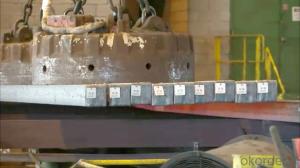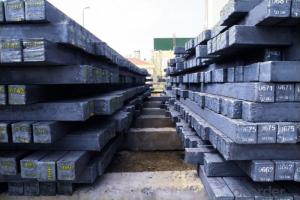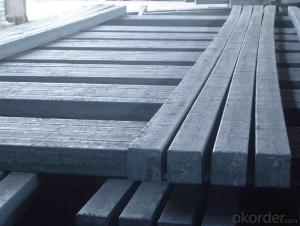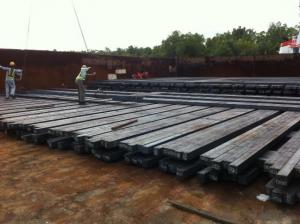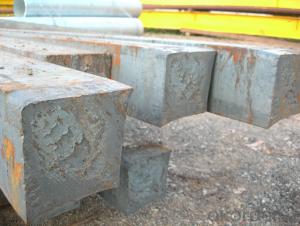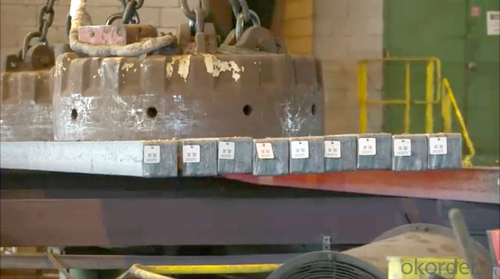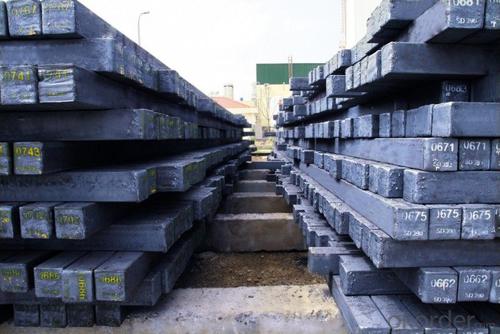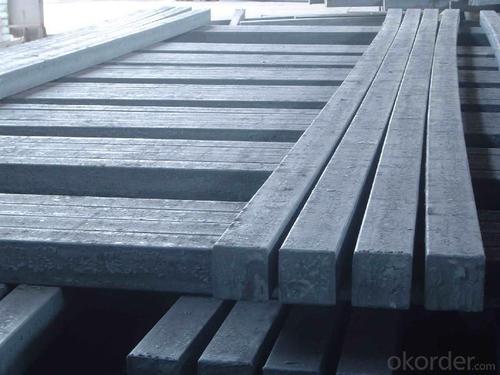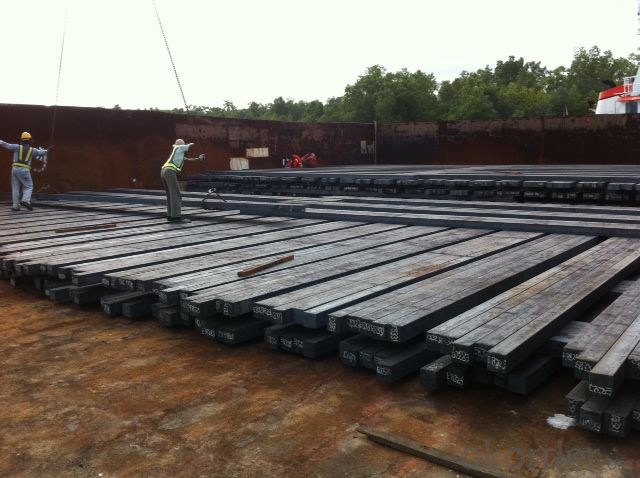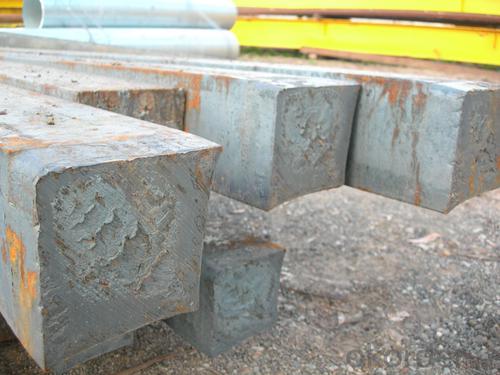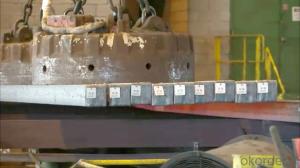Prime quality square alloy steel billet 145mm Q235
- Loading Port:
- Tianjin
- Payment Terms:
- TT OR LC
- Min Order Qty:
- 100 m.t.
- Supply Capability:
- 10000 m.t./month
OKorder Service Pledge
OKorder Financial Service
You Might Also Like
Structure of Prime quality square alloy steel billet 145mm Q235
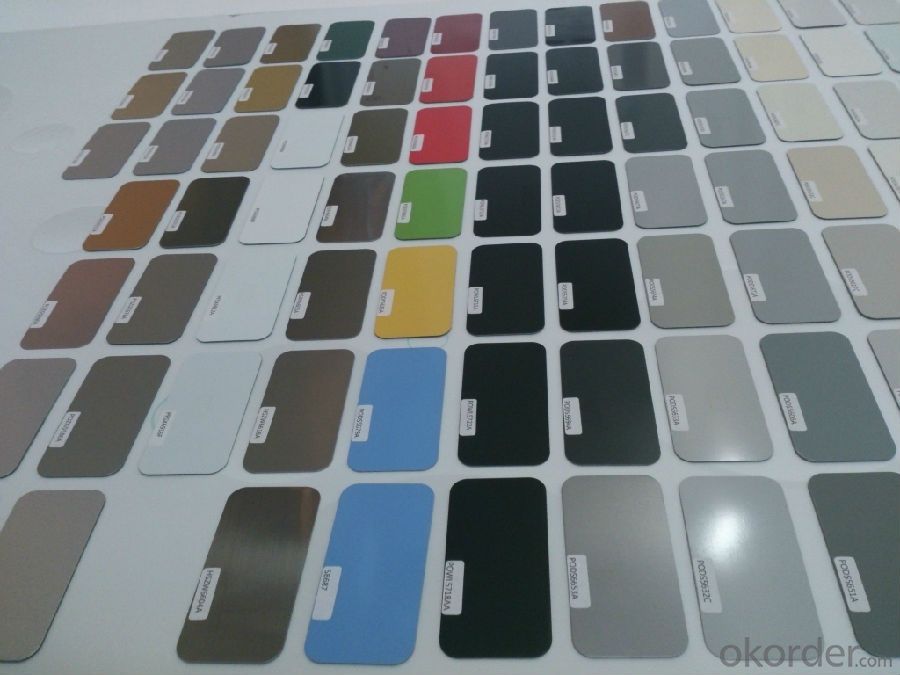
Description of Prime quality square alloy steel billet 145mm Q235
1. Prepainted steel coil is coated with organic layer, which provides higher anti-corrosion property and a longer lifespan than that of galvanized or galvalume steel sheets.
2. The base metals for prepainted steel coil consist of cold rolled, HDGI Steel, electro-galvanized and hot-dip alu-zinc coated steel. The finish coats of prepainted steel coil can be classified into groups as follows: polyester, silicon modified polyesters, polyvinylidene fluoride, high-durability polyester, etc.
3. The production process has evolved from one-coating-and-one-baking to double-coating-and-double-baking, and even three-coating-and-three-baking.
4. The color of the prepainted steel coil has a very wide selection, like orange, cream-colored, dark sky blue, sea blue, bright red, brick red, ivory white, porcelain blue, etc.
5. The prepainted steel coils can also be classified into groups by their surface textures, namely regular prepainted sheets, embossed sheets and printed sheets.
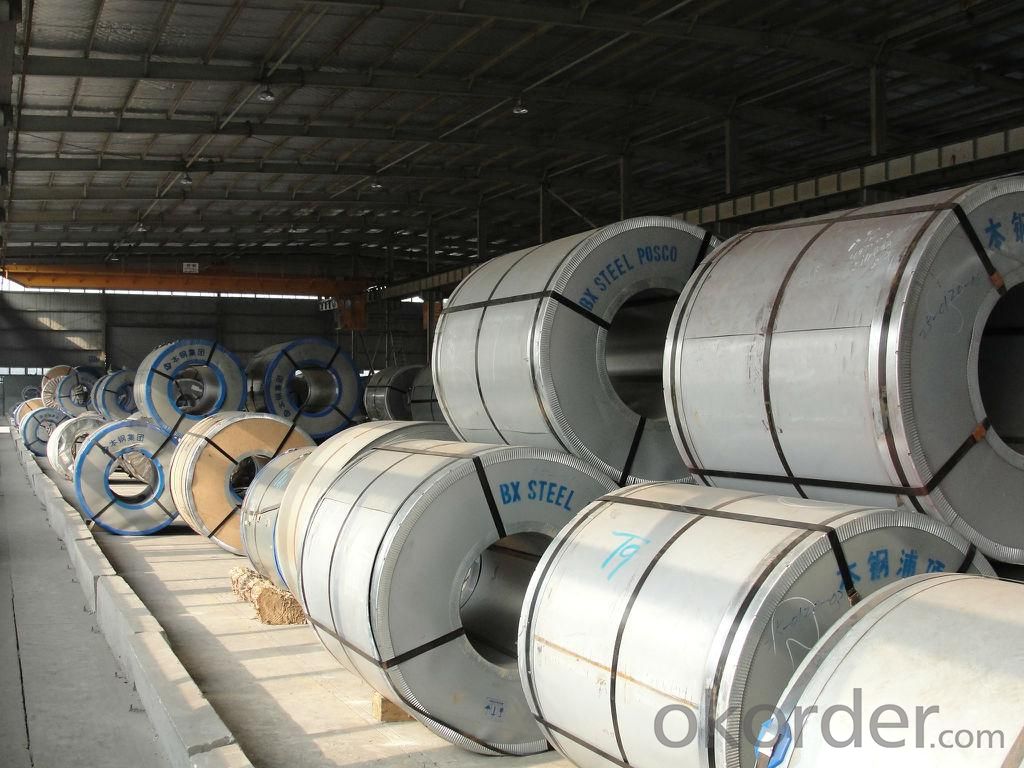
Main Feature of Prime quality square alloy steel billet 145mm Q235
Uncoated CR steel sheet
With the features of in line with the international highest standards in demension and shape, excellent surface finish and properties, the products are mainly used in home appliance and automobile industries.
Galvanized steel sheet(include HDG and EG)
With the features of good corrosion resistance, the products are mainly used in automobile, home appliance, electronics, building and machinery manufacture industries, etc.
Precoated steel sheet
With the features of enviromental protection and good processablility, long lasting surface durability, rich in colors, the products are maily used in building, home appliance and furniture industries, etc.
Applications of Prime quality square alloy steel billet 145mm Q235
Construction
Manufacture anticorrosion, industrial and civil architecture roof boarding, roof grille
Light industries
Home appliance's case, civil chimney, kitchen utensils
Auto industry
Corrosion resistant parts of cars
Agriculture
Food storage, meat and aquatic products' freezing and processing equipment
Commerce
Equipments to store and transport materials, and packing implements
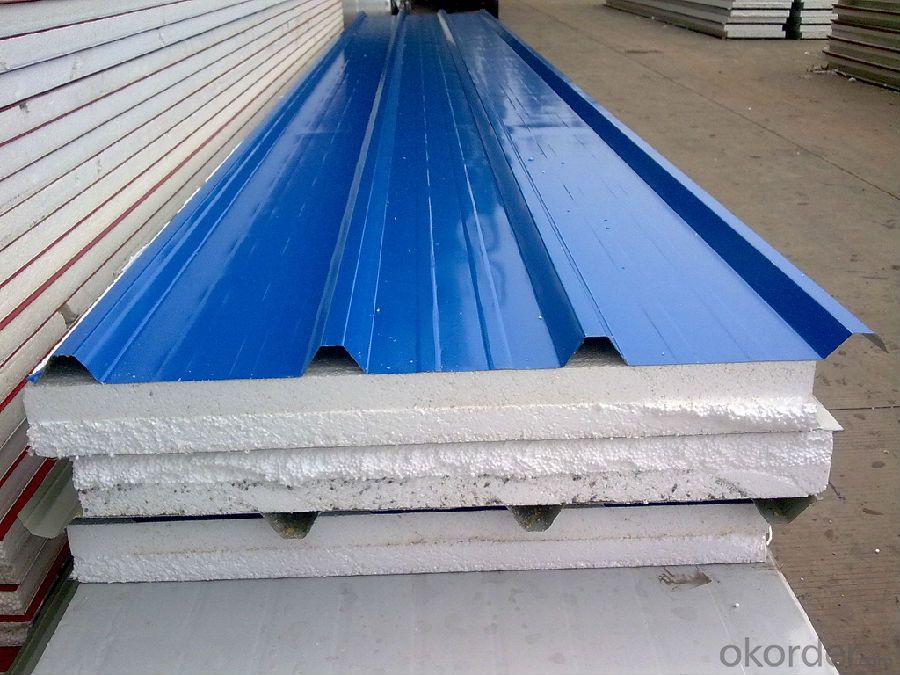
Specifications of Prime quality square alloy steel billet 145mm Q235
Product | Prime quality square alloy steel billet 145mm Q235 |
Material Grade | SGCC / SGCH / DX51D+AZ, etc |
Thickness | 0.6-3.0mm |
Width | 500-1500mm |
Tolerance | Thickness: +/-0.02mm , Width:+/-2mm |
Zinc-coating | Z30-150g/m2 |
Technique | Raw material: Hot rolled steel coil --> Cold rolled_>hot dipped galvalume |
Surface | Dried, Chromated, Unoiled |
Spangle | Regular spangle , small spangle, zero spangle |
ID | 508MM 610MM |
Coil weight | 1-25MT |
Export package | Cardboard inner sleeves, Waterproof paper, galvanized steel covered and steel strip packed |
FAQ of Prime quality square alloy steel billet 145mm Q235
We have organized several common questions for our clients,may help you sincerely:
1. How Can I Visit There?
Our company is located in Tianjin City, China, near Beijing. You can fly to Tianjin Airport Directly. All our clients, from home or aboard, are warmly welcome to visit us!
2. How Can I Get Some Sample?
We are honored to offer you sample.
3. Why choose CNBM?
Our delivery time about 15-20days for standard sizes, if you have other requirements like hardness, quanity and width ,it is about 20-40days. But don't worry we also try our best for the delivery time ,because time longer and our cost is higher.
- Q: What are the main factors affecting the formability of alloy steel billets?
- The main factors affecting the formability of alloy steel billets are the composition of the alloy, the temperature at which the billets are formed, the strain rate during deformation, and the presence of impurities or defects in the material.
- Q: How are steel billets used in the production of seamless pipes?
- Seamless pipes, which are manufactured without welding or seams, require steel billets as a fundamental component in their production process. Steel billets are rectangular-shaped solid pieces of steel that serve as the raw material for seamless pipe manufacturing. To produce seamless pipes, the initial step is melting steel in a furnace to obtain molten metal. This molten steel is then poured into molds to shape steel billets. These billets are then heated to a specific temperature and pierced using a piercing mill. This mill exerts both axial and radial forces, pushing a pointed mandrel through the center of the billet, resulting in a hollow tube or shell. Following the piercing process, the hollow tube is further elongated and reduced in diameter by a series of rolling mills. These mills apply a combination of rotational and compressive forces to shape the billet into the desired seamless pipe size. The seamless pipe undergoes continuous stretching and rolling until it reaches the desired length and diameter. The utilization of steel billets in the production of seamless pipes holds significant importance for several reasons. Firstly, the billets are crafted from high-quality steel, guaranteeing the strength and durability of the final product. Secondly, the uniformity and consistency of the billets allow for precise shaping and seamless pipe dimensions. Lastly, the solid structure of the billets enables them to withstand the intense forces and temperatures involved in the pipe manufacturing process. In conclusion, steel billets assume a crucial role in the production of seamless pipes. From being melted and molded into billets to being pierced, elongated, and rolled, these billets undergo a series of processes that transform them into high-quality seamless pipes. The use of steel billets ensures the integrity and reliability of seamless pipes, making them suitable for various industrial applications.
- Q: How are steel billets used in the production of construction equipment?
- Steel billets are an integral component in the production of construction equipment. These billets, which are essentially semi-finished steel forms, serve as the raw material for various construction equipment components. They are typically manufactured through a process called continuous casting, where molten steel is solidified in molds to form solid rectangular or square billets. Once steel billets are obtained, they undergo further processing to transform them into the desired construction equipment parts. This involves shaping, cutting, and machining the billets to create components such as gears, shafts, axles, and structural frames. The versatility of steel allows for customization of these components to meet the specific requirements of different construction equipment. The use of steel billets in construction equipment production offers several advantages. Firstly, steel is known for its exceptional strength and durability, making it ideal for heavy-duty applications. By using steel billets, construction equipment manufacturers can ensure that their products can withstand the demanding conditions of construction sites and provide long-lasting performance. Additionally, steel billets can be easily welded, allowing for the assembly of complex structures and components. This welding capability is crucial in the production of construction equipment, where multiple parts need to be securely joined together to form a robust and reliable machine. Furthermore, steel billets offer excellent machinability, meaning they can be easily shaped and formed into the desired dimensions. This allows for precise manufacturing of intricate components, enhancing the overall performance and functionality of the construction equipment. Lastly, steel billets are readily available in a wide range of grades and compositions, enabling manufacturers to select the most suitable steel alloy for their specific construction equipment applications. This flexibility allows for the optimization of the equipment's performance, weight, and cost-effectiveness. In conclusion, steel billets play a vital role in the production of construction equipment by serving as the raw material for various components. Their strength, durability, weldability, machinability, and wide range of available alloys make them an ideal choice for manufacturing construction equipment that can withstand the demanding conditions of construction sites and deliver long-lasting performance.
- Q: What are the main challenges in the production of steel billets?
- The main challenges in the production of steel billets include maintaining consistent quality and dimensional accuracy, ensuring proper heat treatment and cooling processes, minimizing defects and surface imperfections, managing energy consumption and environmental impact, and meeting the growing demand for sustainable and cost-effective production methods. Additionally, the industry faces challenges related to raw material availability and cost fluctuations, as well as competition from alternative materials and technologies.
- Q: What are the main factors affecting the formability of stainless steel billets?
- The formability of stainless steel billets is influenced by several key factors. These factors include the steel's composition, the forming temperature, the grain size and structure of the material, and the level of deformation applied during the forming process. To begin with, the composition of the stainless steel billet is a critical factor in determining its formability. The steel's composition, including the presence of alloying elements like chromium, nickel, and molybdenum, impacts its mechanical properties. For instance, higher levels of chromium can enhance corrosion resistance but may reduce formability. Therefore, selecting the appropriate stainless steel grade is essential to ensure optimal formability for a specific application. Furthermore, the temperature at which the stainless steel billet is formed is influential. Elevated temperatures increase the steel's ductility and, consequently, its formability. Heating the billet lowers its yield strength and facilitates easier deformation. However, excessive heating can result in grain growth and diminished mechanical properties. Thus, finding the right balance between temperature and formability is crucial. The grain size and structure of the stainless steel billet also affect its formability. In general, materials with finer grains exhibit better formability compared to those with coarser grains. Finer grains allow for more uniform deformation and reduce the likelihood of cracking or tearing during forming processes. Additionally, the presence of microstructural features like precipitates or twins can also impact the formability of stainless steel billets. Lastly, the amount of deformation applied during the forming process has a significant effect on the formability of the stainless steel billet. Excessive deformation can lead to strain hardening, making the material less ductile and more prone to cracking. Thus, careful control of the amount and distribution of deformation is necessary to achieve optimal formability. In summary, the formability of stainless steel billets is influenced by the composition of the steel, the forming temperature, the grain size and structure of the material, and the level of deformation applied during the forming process. Understanding and managing these factors are essential for achieving the desired formability and ensuring successful manufacturing of stainless steel components.
- Q: How are steel billets used in the manufacturing of pipes and tubes?
- Steel billets are an essential component in the manufacturing of pipes and tubes. These billets, which are typically rectangular or square in shape, serve as the starting point for the production process. They are first heated to a high temperature to make them more malleable and easier to shape. Once heated, the billets are then passed through a series of rollers, where they are gradually formed into a cylindrical shape. This process, known as hot rolling, helps to refine the structure and improve the mechanical properties of the steel. Hot rolling also ensures that the dimensions of the billet are consistent throughout its length. After the initial hot rolling, the billets are further processed through a series of cold rolling and sizing operations. Cold rolling helps to reduce the thickness and improve the surface finish of the billet, while sizing operations ensure that the final product meets the required specifications in terms of diameter, wall thickness, and length. Once the billet has been shaped and sized, it is then cut into specific lengths and welded together to form a seamless or welded pipe or tube. The welding process involves joining the ends of the billets using either electric resistance welding (ERW), submerged arc welding (SAW), or other welding techniques. This helps to create a continuous and strong joint, ensuring the integrity and strength of the pipe or tube. The final step in the manufacturing process involves various finishing operations such as heat treatment, straightening, and inspection. Heat treatment helps to further enhance the mechanical properties of the pipe or tube, while straightening ensures that the final product has a uniform shape and is free from any deformations. Inspection is carried out to ensure that the pipes or tubes meet the required quality standards and specifications. In summary, steel billets play a crucial role in the manufacturing of pipes and tubes. They are transformed through a series of hot and cold rolling processes, welded together, and subjected to various finishing operations to produce high-quality and reliable pipes and tubes.
- Q: What are the different surface treatments for improved corrosion resistance in steel billets?
- There are several different surface treatments that can be applied to steel billets in order to improve their corrosion resistance. These treatments are designed to create a protective barrier on the surface of the steel, preventing the corrosive agents from reaching the underlying metal. Some common surface treatments for improved corrosion resistance in steel billets include: 1. Hot-dip galvanizing: This process involves immersing the steel billets in a bath of molten zinc. The zinc reacts with the steel to form a protective layer of zinc-iron alloy, known as a galvanized coating. This coating provides excellent corrosion resistance and can extend the lifespan of the steel billets. 2. Electroplating: Electroplating is a process in which a thin layer of metal, such as zinc or nickel, is deposited onto the surface of the steel billets using an electric current. This creates a protective barrier that prevents corrosion and provides a decorative finish. 3. Powder coating: Powder coating involves applying a dry powder to the surface of the steel billets and then heating it to form a protective layer. The powder is typically made of a mixture of resin and pigment, which melts and bonds to the steel when heated. Powder coating provides excellent corrosion resistance and is available in a wide range of colors and finishes. 4. Paint coatings: Painting steel billets with corrosion-resistant paint is another effective surface treatment. The paint forms a protective barrier that prevents moisture and corrosive agents from reaching the steel. Multiple layers of paint may be applied to improve the durability and longevity of the coating. 5. Passivation: Passivation is a chemical process that removes free iron and other contaminants from the surface of the steel billets. This helps to prevent the formation of corrosion and promotes the formation of a protective oxide layer. Passivation is often used in combination with other surface treatments, such as electroplating or powder coating, to enhance their corrosion resistance. It is worth noting that the choice of surface treatment for improved corrosion resistance in steel billets depends on various factors such as the environment in which the billets will be used, the desired lifespan of the steel, and the cost considerations. Therefore, it is essential to carefully evaluate the specific requirements and consult with experts to determine the most suitable surface treatment.
- Q: 20 what is the difference between manganese silicon steel billet and Q235 billet?
- 20 manganese silicon steel billet for high strength steel,Q235 billet is almost the most common steel, requiring the lowest.
- Q: How do steel billets contribute to the overall energy efficiency of a structure?
- There are several ways in which steel billets enhance the energy efficiency of a structure. To begin with, steel is an incredibly durable material that can withstand the test of time. Consequently, structures constructed using steel billets have a longer lifespan, which reduces the frequency of maintenance and repairs. As a result, energy consumption and costs decrease over time. Furthermore, steel boasts excellent heat and electricity conductivity. This characteristic facilitates the efficient distribution of thermal energy throughout the structure, thereby reducing the need for additional heating or cooling systems. Steel structures are proficient at regulating internal temperature and minimizing energy loss, resulting in improved energy efficiency. Moreover, steel manufacturing processes have become increasingly energy-efficient in recent years. Modern techniques involve recycling scrap steel, utilizing electric arc furnaces, and implementing advanced technologies to minimize energy consumption during the production of steel billets. This emphasis on energy efficiency during the manufacturing stage translates into reduced environmental impact and energy savings throughout the lifespan of the structure. Additionally, steel structures can be designed to optimize natural lighting and ventilation. This reduces reliance on artificial lighting and mechanical ventilation systems. Incorporating features like large windows, skylights, and well-designed air circulation systems enables steel structures to minimize the need for energy-consuming lighting fixtures and HVAC systems, further enhancing energy efficiency. In conclusion, steel billets contribute to the overall energy efficiency of a structure through their durability, thermal conductivity, and energy-efficient manufacturing processes. By opting for steel as a building material, structures can benefit from reduced maintenance requirements, efficient temperature regulation, and minimized energy consumption. This leads to long-term energy savings and a more sustainable built environment.
- Q: How do steel billets contribute to the overall aesthetics of a product?
- Steel billets play a crucial role in enhancing the overall aesthetics of a product in several ways. Firstly, the quality and finish of steel billets greatly impact the appearance of the final product. Steel billets are often used as raw material for various manufacturing processes such as forging, rolling, or machining. The smooth surface and uniform shape of high-quality steel billets contribute to a sleek and refined look of the end product. Additionally, steel billets offer designers and manufacturers a wide range of possibilities in terms of shape and size. They can be easily customized and transformed into various forms, allowing for intricate and unique designs that enhance the visual appeal of the product. Steel billets can be molded, cut, or manipulated to create complex patterns, textures, or contours, offering endless opportunities for artistic expression. Moreover, the strength and durability of steel billets contribute to the longevity and resilience of the final product. Aesthetics are not only about visual appeal but also about the perception of quality. Steel billets, known for their robustness and resistance to corrosion, provide a sense of reliability and sturdiness. This perceived quality enhances the overall attractiveness of the product, making it more desirable to consumers. In summary, steel billets contribute to the overall aesthetics of a product by providing a high-quality, customizable, and durable raw material. Their smooth surface, versatility in shaping, and inherent strength enhance the visual appeal, allowing designers to create visually captivating and long-lasting products.
Send your message to us
Prime quality square alloy steel billet 145mm Q235
- Loading Port:
- Tianjin
- Payment Terms:
- TT OR LC
- Min Order Qty:
- 100 m.t.
- Supply Capability:
- 10000 m.t./month
OKorder Service Pledge
OKorder Financial Service
Similar products
Hot products
Hot Searches
Related keywords
